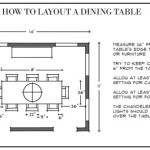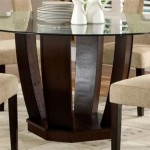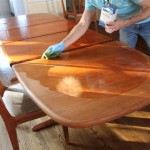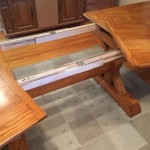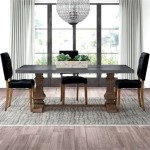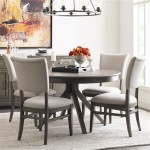Dining Table: Wood Top, Metal Legs - A Guide to Style and Function
The dining table serves as a central hub in many homes, acting as a gathering place for meals, conversations, and shared experiences. The selection of a dining table involves numerous considerations, including size, shape, material, and style. A popular and enduring design choice involves pairing a wood top with metal legs. This combination offers a compelling blend of natural warmth and industrial chic, providing versatility to complement a wide range of interior design aesthetics.
The decision to incorporate a wood top, metal legs dining table into a living space requires careful consideration of the specific characteristics of each material, the overall design intent, and the practical needs of the individuals using the table. This article will explore the key aspects of this dining table style, providing information to assist in making an informed purchasing decision.
Material Considerations: Wood and Metal
The selection of materials significantly impacts the appearance, durability, and longevity of a dining table. Understanding the properties of wood and metal is crucial.
Wood: Wood offers a wide range of options, each with distinct characteristics. Hardwoods like oak, maple, and walnut provide exceptional durability and resistance to wear and tear. These woods typically feature denser grains and are less susceptible to dents and scratches. Softwoods, such as pine and fir, are often more affordable but are more prone to damage. The type of wood chosen also influences the aesthetic of the table. Oak offers a classic, versatile look; maple provides a lighter, cleaner appearance; and walnut boasts a rich, dark tone. The finish applied to the wood also plays a vital role. A clear finish highlights the natural grain and color of the wood, while stains can alter the color to complement the surrounding decor. Protective coatings like polyurethane or lacquer provide resistance against spills and scratches, enhancing the table's longevity.
The sourcing of the wood is an important consideration too. Opting for sustainably sourced wood ensures responsible forestry practices and minimizes environmental impact. Certifications like the Forest Stewardship Council (FSC) indicate that the wood has been harvested in an environmentally and socially responsible manner.
Metal: Metal legs offer a robust and contemporary aesthetic. Steel is a popular choice due to its strength and durability. It can be finished in various ways, including powder coating, which provides a durable, scratch-resistant surface. Stainless steel offers excellent corrosion resistance, making it suitable for environments with higher humidity. Iron legs provide a more rustic, industrial look. The gauge (thickness) of the metal significantly impacts its strength and stability. Thicker metal legs provide greater support and minimize the risk of wobbling or bending. The finish applied to the metal also affects its appearance and durability. Matte finishes offer a more subdued look, while glossy finishes create a more modern, polished aesthetic.
The design of the metal legs can vary widely, from simple, straight legs to more elaborate, geometric designs. The style of the legs should complement the overall design of the table and the surrounding decor. Consider the weight capacity of the metal legs, especially if you plan to use the table for heavy items or frequently host large groups.
Design and Style Compatibility
The combination of a wood top and metal legs offers a remarkable degree of design versatility. This pairing can seamlessly integrate into various interior design styles, from modern and industrial to rustic and farmhouse.
Modern: In modern settings, a wood top with sleek, minimalist metal legs creates a clean and sophisticated look. Opt for a light-colored wood like maple or birch with a clear finish to emphasize the natural grain. The metal legs should be simple and geometric, perhaps in a matte black or brushed stainless steel finish. Avoid ornate details or excessive ornamentation.
Industrial: An industrial aesthetic benefits from a wood top with distressed or reclaimed wood. The metal legs should be robust and utilitarian, perhaps with a raw steel finish or a dark, powder-coated finish. Consider incorporating exposed bolts or welding marks to enhance the industrial feel. The wood top can be thicker and more rugged to complement the sturdy metal legs.
Rustic: For a rustic or farmhouse-style dining room, opt for a wood top with a natural, unfinished look. Choose a wood with visible knots and grain variations to add character. The metal legs can be simple and sturdy, perhaps with a dark, wrought iron finish. Consider incorporating elements like x-shaped legs or decorative metal accents to enhance the rustic charm.
Transitional: A transitional style blends traditional and modern elements. A wood top with a classic wood like oak or walnut can be paired with metal legs in a more contemporary design. Consider legs with a slightly curved shape or a unique geometric pattern. The finish on both the wood and metal should be carefully chosen to create a cohesive and balanced look.
Consider the shape of the tabletop. Rectangular tables are suitable for larger dining rooms and can accommodate more seating. Round tables promote conversation and create a more intimate atmosphere. Oval tables offer a balance between rectangular and round shapes. Square tables can be a good option for smaller spaces.
Practical Considerations: Size, Shape, and Maintenance
Beyond aesthetics, practical considerations play a crucial role in selecting a dining table. Size, shape, and maintenance requirements all influence the suitability of a particular table for a given space and lifestyle.
Size: The size of the dining table should be proportional to the size of the dining room. Allow at least 3 feet of space between the table and the walls or other furniture to ensure comfortable movement. Consider the number of people who will regularly use the table and the number of people you typically host for meals. A general rule of thumb is to allow approximately 24 inches of space per person along the perimeter of the table.
Shape: The shape of the table also impacts its functionality. Rectangular tables are ideal for maximizing seating capacity and are well-suited for formal dining rooms. Round tables encourage conversation and are better suited for smaller groups. Oval tables offer a compromise between rectangular and round shapes. Square tables are a good option for small spaces and can be easily expanded with leaves.
Maintenance: Wood tops require regular cleaning and maintenance to prevent damage and maintain their appearance. Wipe up spills immediately with a soft cloth to prevent staining. Use coasters and placemats to protect the surface from heat and scratches. Regularly dust the table with a soft cloth to remove dust and debris. Depending on the finish, you may need to periodically apply a furniture polish or wax to protect the wood and enhance its shine. Metal legs are generally easier to maintain. Wipe them down with a damp cloth to remove dust and dirt. Avoid using harsh chemicals or abrasive cleaners that could damage the finish.
The weight of the table should also be considered. A heavier table will be more stable and less likely to tip over, but it will also be more difficult to move. Consider the ease of assembly and disassembly, especially if you plan to move the table frequently.
Finally, consider the price point. Wood top, metal legs dining tables are available in a wide range of price points, depending on the materials used, the craftsmanship, and the brand. Set a budget before you begin shopping and compare prices from different retailers to find the best value.
By carefully considering these material, design, and practical considerations, selecting a wood top, metal legs dining table can be a rewarding process, resulting in a piece of furniture that enhances the beauty and functionality of the dining space for years to come.

Modern Dining Table What We Make

Steel Table Legs Dining Set Of 2 Style Etsy Room Design Modern

Modern Dining Table What We Make

Dining Table With Wooden Top Black Metal Legs Foster Furniture123

Modern Dining Table What We Make

Contemporary Walnut Dining Table Steel Legs Metal Base Coffee

Popular Design Nature Solid Timber Table Metal Legs Natural Wood Top Simple China Dining Furniture Made In Com

Reclaimed Wood Top Dining Table With Metal Legs Kirklands Home

Welwick Designs 60 In Rectangle Rustic Oak Wood Top Modern Dining Table With Metal Legs Seats 6 Hd9397 The Home

Welwick Designs 60 In Rectangle Rustic Oak Wood Top Modern Dining Table With Metal Legs Seats 6 Hd9397 The Home

